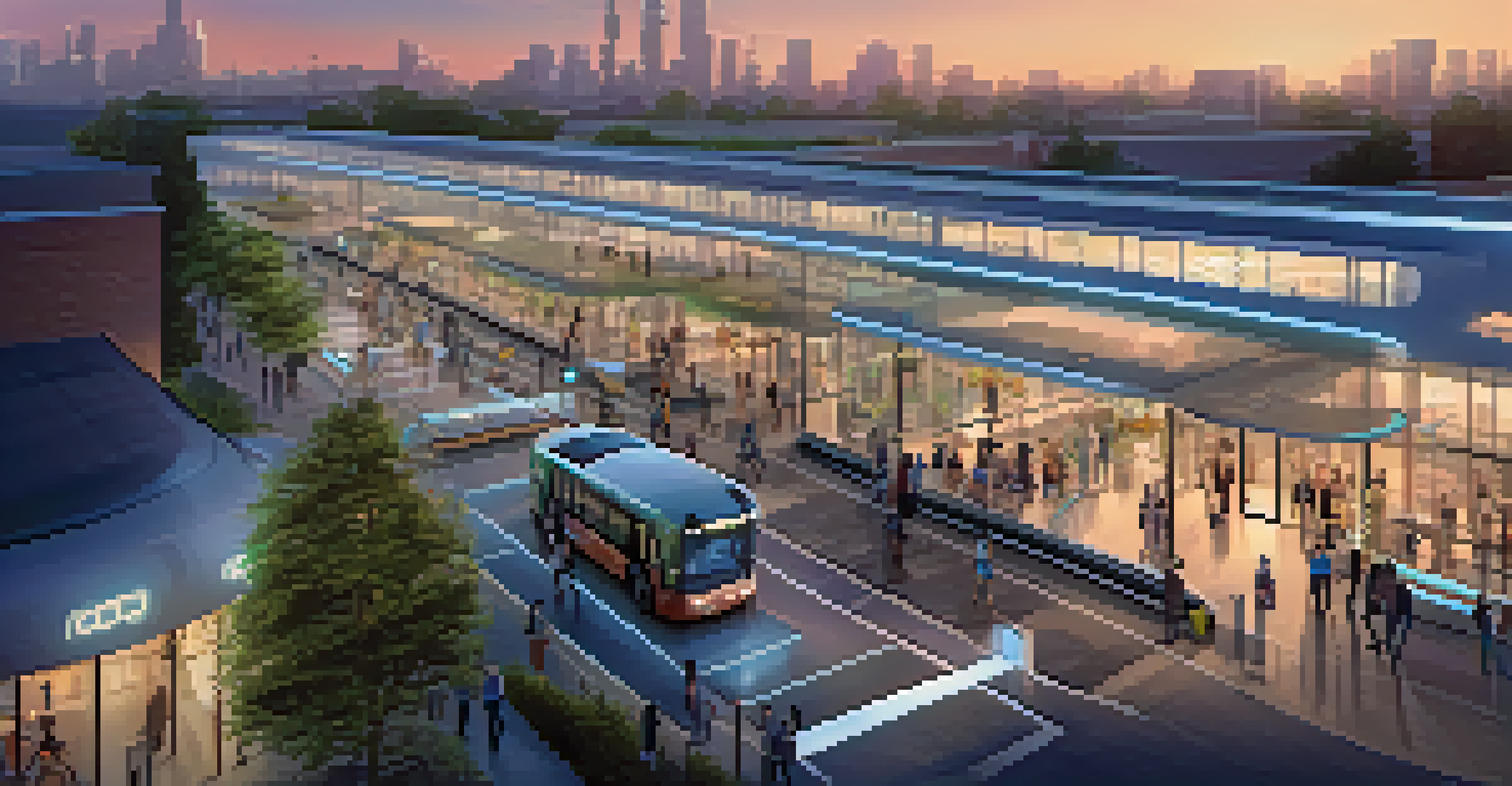Enhancing Urban Mobility to Reduce Carbon Footprint

Understanding Urban Mobility and Its Importance
Urban mobility refers to the movement of people within city spaces, encompassing various modes of transportation, from walking and cycling to public transit. As cities grow, the demand for efficient urban mobility increases, impacting both the environment and quality of life. Enhancing urban mobility is crucial not only for reducing congestion but also for minimizing the carbon footprint associated with transportation.
Sustainable transport is not a choice; it is a necessity for the future of our cities.
The way we move in urban areas can significantly contribute to greenhouse gas emissions. For instance, a single car journey can emit more carbon than several public transport trips combined. By exploring and implementing sustainable mobility options, cities can promote healthier, cleaner environments while also improving accessibility for all residents.
Ultimately, understanding urban mobility is the first step toward creating solutions that benefit both the planet and urban dwellers. By prioritizing efficient and eco-friendly transportation, cities can pave the way for a more sustainable future.
The Role of Public Transportation in Reducing Emissions
Public transportation plays a pivotal role in decreasing urban carbon emissions. Buses, trains, and trams transport numerous individuals simultaneously, thus reducing the number of cars on the road. For example, a single bus can replace up to 50 cars, significantly lowering greenhouse gas emissions while also alleviating traffic congestion.

Moreover, modernizing public transit systems with electric or hybrid vehicles can further enhance their eco-friendliness. Cities like Amsterdam have successfully integrated electric buses into their fleets, lowering their overall carbon footprint. By investing in clean public transport, urban areas can encourage more residents to choose these options over personal vehicles.
Urban Mobility Enhances Quality of Life
Efficient urban mobility reduces congestion and carbon emissions, improving both environmental health and residents' daily experiences.
In summary, robust public transportation systems are essential not only for providing convenient travel options but also for achieving sustainability goals. As cities invest in cleaner public transport, they contribute to a healthier environment and a more efficient urban landscape.
Promoting Cycling and Walking as Viable Options
Encouraging cycling and walking can drastically reduce urban carbon emissions. These modes of transportation are not only environmentally friendly but also promote healthier lifestyles. Cities that invest in bike lanes, pedestrian paths, and safety measures make cycling and walking more appealing to residents, allowing them to opt for greener travel options.
The future will be about a low-carbon economy, and urban transportation will be at the heart of this transformation.
For instance, Copenhagen is renowned for its cycling culture, where nearly 40% of residents commute by bike. This commitment to cycling infrastructure has helped the city lower its carbon emissions while improving public health. By prioritizing cycling and walking, urban planners can foster a culture of sustainability in their communities.
Ultimately, promoting these active transportation modes is about making the choice to go green easier for everyone. As cities recognize the benefits of cycling and walking, they contribute to a more sustainable and enjoyable urban experience.
Integrating Technology for Smarter Mobility Solutions
Technology has the power to revolutionize urban mobility and significantly reduce carbon footprints. Smart solutions such as ride-sharing apps, electric vehicle (EV) charging stations, and real-time public transport tracking can enhance the efficiency of urban transportation systems. By leveraging technology, cities can facilitate seamless travel experiences for their residents.
For example, platforms like Uber and Lyft have introduced ride-sharing services that allow multiple passengers to share a ride, thus decreasing the number of vehicles on the road. Additionally, cities are increasingly adopting electric scooters and bikes, providing residents with eco-friendly options for short trips. These innovations not only reduce emissions but also promote convenience.
Public Transport Reduces Emissions
Investing in modern public transportation systems is crucial for lowering urban carbon footprints and promoting sustainable travel.
Incorporating technology into urban mobility strategies is essential for creating smarter, more sustainable cities. As technology continues to advance, it presents new opportunities for reducing carbon footprints while improving accessibility and efficiency.
The Benefits of Car-Free Zones in Urban Areas
Car-free zones are gaining popularity in urban planning as they provide numerous environmental and social benefits. By restricting vehicle access in certain areas, cities can reduce traffic congestion, lower emissions, and create more pedestrian-friendly spaces. These zones often lead to vibrant public spaces where people can gather, socialize, and enjoy a healthier environment.
Cities like Barcelona and Paris have successfully implemented car-free zones, resulting in cleaner air and safer streets. Residents and visitors can experience the benefits of walking, cycling, and using public transport without the interference of heavy traffic. This not only enhances the quality of life but also encourages more sustainable transportation habits.
Ultimately, car-free zones represent a tangible step toward reducing urban carbon footprints. As more cities embrace this concept, they can create healthier, more livable environments for everyone.
Community Engagement: Involving Residents in Urban Planning
To effectively enhance urban mobility, community engagement is essential. Involving residents in the decision-making process ensures that transportation solutions reflect the needs and preferences of the community. By hosting workshops, surveys, and public forums, cities can gather valuable feedback that informs sustainable mobility initiatives.
For example, cities that actively engage their residents often find that people are more likely to embrace new transportation options. When individuals feel invested in their community's development, they become more inclined to adopt eco-friendly practices. This collaborative approach not only fosters a sense of belonging but also empowers residents to take part in creating a greener future.
Community Involvement Drives Change
Engaging residents in urban planning ensures that mobility solutions meet community needs and foster eco-friendly practices.
Ultimately, community engagement plays a vital role in successful urban mobility planning. By fostering open communication and collaboration, cities can develop sustainable solutions that resonate with their residents and contribute to a lower carbon footprint.
Policy Changes Needed to Support Sustainable Mobility
Effective policy changes are crucial for promoting sustainable urban mobility. Governments need to support initiatives that prioritize public transportation, cycling, walking, and other eco-friendly solutions. This may include investing in infrastructure, offering incentives for electric vehicle use, or implementing congestion pricing to discourage car usage in busy areas.
For instance, cities that have adopted policies encouraging the use of public transit through subsidies or reduced fares have seen increased ridership. These policies not only promote sustainable transportation but also showcase a commitment to reducing carbon emissions. By aligning policies with sustainability goals, urban areas can create a coherent framework that supports greener mobility options.

In conclusion, advocating for policy changes is essential for fostering a culture of sustainable urban mobility. As cities reevaluate their transportation frameworks, they can play a pivotal role in shaping a more environmentally friendly future.
The Future of Urban Mobility and Its Impact on the Environment
The future of urban mobility holds exciting possibilities for reducing carbon footprints. As cities continue to innovate and adapt their transportation systems, we can expect to see a greater emphasis on sustainability. Emerging trends, such as autonomous vehicles, electric public transit, and improved bike-sharing programs, are set to transform how we navigate urban spaces.
Moreover, integrating renewable energy sources into transportation infrastructure can further enhance sustainability efforts. For example, solar panels on public transit stations can power electric buses, creating a closed-loop system that minimizes emissions. These advancements represent a step toward a future where urban mobility aligns with environmental responsibility.
In summary, the future of urban mobility is intertwined with our commitment to sustainability. By embracing innovative solutions and prioritizing eco-friendly practices, cities can lead the way in reducing carbon footprints while improving the quality of life for residents.